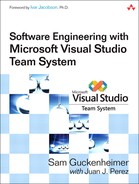Contents
CHAPTER 1. A Value-Up Paradigm
What Software Is Worth Building?
Fit the Process to the Project
Different Horizons, Different Granularity
Fit the Process to the Project
Required Documentation Versus Tacit Knowledge
Implicit Versus Explicit Sign-Off Gates and Governance Model
Auditability and Regulatory Concerns
Prescribed Versus Self-Organization
One Project at a Time Versus Many Projects at Once
Geographic and Organizational Boundaries
Personas and Scenarios and Their Alternatives
Exciters, Satisfiers, and Dissatisfiers
Using Descriptive Rather Than Prescriptive Metrics
Many Dimensions of Project Health
Actual Quality Versus Planned Velocity
What Makes Triage Effective: The Red Line
Escalating and Resolving Issues
CHAPTER 5. Architectural Design
A Value-Up View of Architecture
Constraints with Degrees of Freedom
Validate Architectural Decisions
VSTS and Service-Oriented Architecture
A Value-Up View of Development
Quality from a Developer’s Point of View
Using Test-Driven Development to Ensure Requirements Clarity
Addressing Programming Errors with Code Reviews, Automated and Manual
Providing Immediate Feedback with Unit Tests and Code Coverage
Are We Delivering the Customer Value?
Insulating Your Tests from UI Changes
Are the Qualities of Service Fit for Use?
Does It Work in Production as Well as in the Lab?
Which Tests Should Be Automated?
How Efficient Is Our Team, Or Our Outsourced Team?
Bug Reporting Is Like Journalism
CHAPTER 9. Troubleshooting the Project
Development Practices Too Loose
